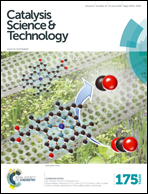Role of different coordinated Cu and reactive oxygen species on the highly active Cu–Ce–Zr mixed oxides in NH3-SCO: a combined in situ EPR and O2-TPD approach†
Abstract
Novel Cu–Ce–Zr mixed oxides were synthesized by a citric acid sol–gel method, and they exhibited an excellent NH3-SCO activity (180 °C, TOF = 1.33 h−1). The finely dispersed CuO, Cu–Ce–Zr solid solution and monomeric Cu2+ ions in octahedral sites were the main active sites. The finely dispersed CuO species were the NH3 adsorption sites, and their adsorption capacity could be improved by their good reducibility. The Cu–Ce–Zr solid solution was an important intermediate in oxygen transfer from bulk to surface. In situ EPR analysis indicated that the isolated Cu2+ located in the octahedral sites was more active compared with that located in the square-planar pyramidal sites, and it induced the formation of more Cu–Ce–Zr solid solution. Meanwhile, the in situ O2-TPD results showed that both adsorbed oxygen and bulk lattice oxygen were the active oxygen adspecies, and the adsorbed oxygen molecules were more active than the bulk lattice oxygen in NH3 oxidation.



 Please wait while we load your content...
Please wait while we load your content...